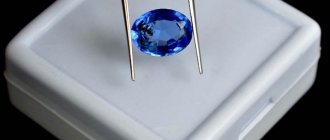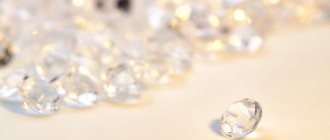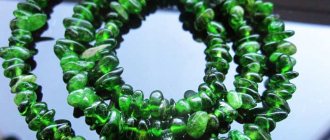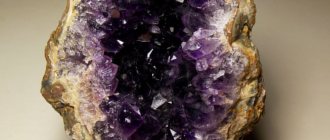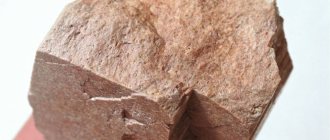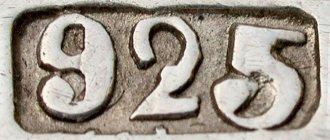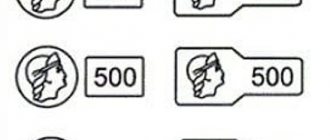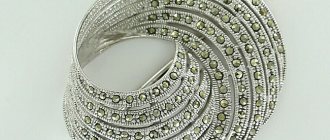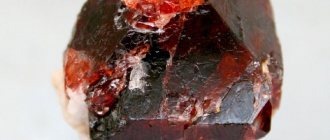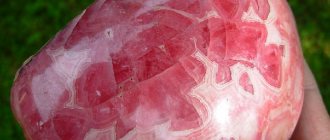The sapphire gemstone, in its chemical composition, belongs to aluminum oxides; gemologists call this mineral corundum. The peculiarities of its crystal lattice and maturation are such that it is not so common to come across natural corundum of jewelry quality. In nature, this layered substance, covered with small cracks, is usually found translucent, lacking the rich hue for which sapphires are highly valued. Another problem that jewelers face is the uneven concentration of impurities. And various contaminants accumulate in natural cracks. To improve the quality of the stone and give it jewelry value, craftsmen use various techniques, the purpose of which is to refine the sapphire.
Traditional methods
The most ancient method of improving the quality of sapphires is to immerse them in boiling natural oil, resin or wax. This method has long remained in history, in contrast to another, also known to the masters of antiquity - calcination of corundum using high temperatures. This method allows you to significantly thicken the color and achieve a richness worthy of Kashmir sapphires from an unsaturated stone. Calcination was most widespread among craftsmen on the island of Sri Lanka, since local sapphires are usually lightly colored. Increasing the heating temperature of corundum makes it possible to obtain a stone with the effect of asterism, which appears on the surface of a 6- or 12-rayed star.
With the development of technology, calcination has taken on new forms. Now the minerals are heated in an electromagnetic furnace, increasing the pressure if necessary. In order to lighten excessively dark blue corundums, they are heated to 800°C in a highly acidic environment.
Preparing for this study
This research was prompted by a comment by renowned Australian gemologist Terry Coldham in 2021. In Bangkok, he ran into a friend who owned a lot of Madagascar sapphire. Mr Coldham's friend said he was going "to the burner", hoping to "sweeten" the color with a low-temperature treatment that would lighten the stones' hue. He pointed out that the temperature they use is likely below 1000°C. This coincided with the Bemainti sapphire rush, which introduced high quality blue sapphires to the world, ranging from lighter colors (lower iron content) to deeper blue examples (higher iron content).
The abundance of blue sapphires from Madagascar being tested at Lotus Gemology in Bangkok, along with rumors of low temperature heat treatment, necessitated further research and experimentation into heat treatment of this material. Our goal was to record the characteristics of Madagascar sapphires.
Healing of cracks
Craftsmen who process stones often have to deal with the problem of corundum cracking. To improve the quality and increase the jewelry value of a stone, several special methods are used.
The most common and effective is heating sapphire in an oxygen-aluminum mixture. This mixture is identical to the chemical composition of the mineral and perfectly cements cracks. The only disadvantage of the procedure is that the cracks are eventually filled with leucosapphire (its colorless variety), which is easily detected at high magnification. However, the advantages of this type of crack healing are significantly greater than the disadvantages.
In the middle of the 20th century, epoxy resin began to be used in jewelry. It can also reliably fill cracks in corundum, while slightly changing its color. A ray of light refracted on the edges of a foreign substance flashes with bright, saturated colors from purple to pink. The same effect is achieved by filling the cavities of the mineral with various glass.
Geology
Approximately 750-500 million years ago, Madagascar was part of the supercontinent Gondwana, sandwiched between East Africa, South India and Sri Lanka. Today, this region, known as the Mozambique Belt, contains some of the world's richest deposits of corundum. Many of the regions that were part of this belt are now the world's leading producers of ruby and sapphire.
OLYMPUS DIGITAL CAMERA
The island of Madagascar, widely known for its biological diversity, has an incredible wealth of precious stones. By some estimates, potentially 90% of the earth is gemstone deposits. Most of the important finds of rubies and sapphires are recorded in the eastern part of the island. In the south of the country there is notable production of both blue sapphire and unusual colored sapphire, with mining and trade centered around the town of Ilacaca.
Impregnation and diffusion
To improve shades, give greater depth and saturation, technologies have now been developed for impregnation with beryllium and introducing iron and vanadium ions into the mineral. The first method is more often called impregnation, the second - diffuse processing.
Beryllium is commonly used to improve the color of pinkish and yellowish stones. After processing, they acquire a rich yellow or orange tint. Moreover, if the mineral is no more than 3 mm, then beryllium will completely saturate it. It is not yet possible to completely change the color of large sapphires; there will still be an unpainted area in the center.
The diffusion processing method is used to give faintly colored blue corundums greater depth and color saturation. The essence of this method is that iron and vanadium atoms affect the ability of the crystal lattice to transmit the visible spectrum of radiation. This treatment also does not affect the central areas and is easily determined at high magnification.
Despite the fact that any methods of changing the color of sapphires do not affect their properties and, in general, do not significantly change the stone, international rules require that the certificate indicate which of the two methods the mineral was processed.
Methods for increasing the jewelry quality of sapphires are irreversible. They do not lose the color obtained during processing; the materials with which the cracks were filled will remain in the stone forever. Treated minerals do not require special care.
Ennoblement
It is characteristic of corundums that most of them are subjected to various types of refining. It is usually aimed at improving color, and with the help of refining it is also possible to improve their purity. The most common type of refining of sapphires is heat treatment. In this type of processing, they are heated in special furnaces to temperatures in the range of 800-1900 degrees. As a result of heating, the color can become more saturated, it is also possible to lighten too dark stones or remove unwanted shades that reduce cost. The improvement in cleanliness resulting from heating occurs because the fine, needle-like rutile inclusions, which often form noticeable whitish clumps, can melt. About 90% of all mined blue corundum is subjected to heat treatment.
The cost of an unheated sapphire can be approximately 1.5-2 times higher than that of similar quality, but heated. This is because unheated sapphires with good natural color are significantly rarer. There are also stones on the world market that have undergone heat treatment in the presence of titanium oxide, this is the so-called titanium diffusion. In this case, only the near-surface coloring of the faceted stone occurs in a brighter blue color. During recutting, such a layer can be removed, and then we will see that the original color was pale. These are the two most common types of refining of blue and dark blue corundums. Because Since the presence or absence of refining greatly influences the price, in addition to the words of the supplier, it is desirable that the non-refining be confirmed by an expert opinion from a well-known independent gemological laboratory.
In the video: a large natural sapphire refined by titanium diffusion. Only the surface layer of the stone is painted bright blue.
Myths about sapphires on the Internet
On the Internet you can read the following about sapphires:
- Products containing sapphire should be stored in a dark place.
- Their coloring is unstable
- The crystal may become cloudy or change color
- Diffuse-colored sapphires are the cheapest and are most often passed off as naturally occurring stones.
- It may get scratched.
The last statement of some sellers is very surprising, because on the Mohs scale its hardness is 9, and diamond is 10. How can it scratch?
The rest is only partly true.
For example: - As a standard, all pale sapphires are heated and irradiated, due to this they receive color. — And for cheap raw materials, heat treatment is carried out additionally in order to hide defects. — If the quality of the source material is poor, or sometimes if the technology is violated, the crystals inside still remain light. As a result, in terms of the quality of the stone, a refined sapphire can be more expensive than a natural unheated one; this can only be determined using special equipment. —Can you distinguish diffusely colored blue sapphire from doublet and synthetic sapphire by eye? - Then you need a gemologist.
Go to menu
Which sapphires are better
- The most beautiful and expensive stones are those from Kashmir, which are blue or blue in color. Burmese sapphires are darker, while Sri Lankan crystals are usually paler than Kashmiri sapphires.
- Stones of rich cornflower blue color are considered the best; dark samples are less valuable.
- The equally beautiful shine of the stone in sunlight and artificial lighting indicates the high quality of the crystal.
- Unheated sapphires are more expensive than refined ones, but specimens that are naturally of high quality are extremely rare.
Go to menu
Heated sapphire or not
Synthetic stones are inexpensive 'consumer goods', but there are also cheap natural stones.
The most expensive ones are natural ones that are not heated. The rest are heated sapphires, those that have undergone a standard heat treatment procedure. Heat treatment is performed to improve the color of the stone.
In addition, heat treatment can also be used to improve transparency, that is, the raw materials from which they are made are of low quality, which means such a stone is inexpensive.
Only an experienced specialist can distinguish whether a crystal is heated or not, whether there are cracks or impurities.
Myths about sapphires on the Internet
On the Internet you can read the following about sapphires:
- Products containing sapphire should be stored in a dark place.
- Their coloring is unstable
- The crystal may become cloudy or change color
- Diffuse-colored sapphires are the cheapest and are most often passed off as naturally occurring stones.
- It may get scratched.
The last statement of some sellers is very surprising, because on the Mohs scale its hardness is 9, and diamond is 10. How can it scratch?
The rest is only partly true.
For example: - As a standard, all pale sapphires are heated and irradiated, due to this they receive color. — And for cheap raw materials, heat treatment is carried out additionally in order to hide defects. — If the quality of the source material is poor, or sometimes if the technology is violated, the crystals inside still remain light. As a result, in terms of the quality of the stone, a refined sapphire can be more expensive than a natural unheated one; this can only be determined using special equipment. —Can you distinguish diffusely colored blue sapphire from doublet and synthetic sapphire by eye? - Then you need a gemologist.
Go to menu
Which sapphires are better
- The most beautiful and expensive stones are those from Kashmir, which are blue or blue in color. Burmese sapphires are darker, while Sri Lankan crystals are usually paler than Kashmiri sapphires.
- Stones of rich cornflower blue color are considered the best; dark samples are less valuable.
- The equally beautiful shine of the stone in sunlight and artificial lighting indicates the high quality of the crystal.
- Unheated sapphires are more expensive than refined ones, but specimens that are naturally of high quality are extremely rare.
Go to menu
Sapphires price per carat
The price of inexpensive samples starts from $40 per carat. The cost of a high quality natural sapphire will be from $500 to $1200 per carat. Stones weighing more than 2 carats are rare and are the most expensive.
Today in Sri Lanka, a stone with a certificate can be bought for $500-1000 per carat. For good samples of unheated sapphires, the price starts at $2000. However, a hemological certificate does not provide a 100% guarantee; an assessment by a specialist is still needed.
Go to menu
Sapphires price per carat
The price of inexpensive samples starts from $40 per carat. The cost of a high quality natural sapphire will be from $500 to $1200 per carat. Stones weighing more than 2 carats are rare and are the most expensive.
Today in Sri Lanka, a stone with a certificate can be bought for $500-1000 per carat. For good samples of unheated sapphires, the price starts at $2000. However, a hemological certificate does not provide a 100% guarantee; an assessment by a specialist is still needed.
Go to menu
Sapphire grading
The assessment is made according to the “4C” rule: Clarity, Color, Cut, Carat weight (purity, color, cut, weight).
- Cleanliness Impossible without special equipment. Small inclusions invisible to the eye can devalue your investment in a stone.
- Color The color of a sapphire has a direct impact on the price of the stone. The color depends on the origin, the main ones being Kashmir, Sri Lanka and Ceylon.
- Cut Cutting is primarily designed to reveal the beauty of the stone, and the property of sapphire to sparkle in different colors (pleochroicity) makes the skill of the cutter one of the criteria for evaluating the stone.
- Weight, in carats As already mentioned, stones over 2 carats are extremely rare and expensive; this is a major investment. A stone weighing 1 carat is considered large, less than 0.3 carats is considered small (to represent the size of a crystal, 1 ct = 1/5 gr.).
Go to menu
How to distinguish a real yellow sapphire from a fake
It is not easy to independently distinguish a gemstone from an artificially grown one or a fake, but it is possible. The most inexpensive imitation is painted glass. The stone has a higher hardness and refractive index, and there are no gas bubbles.
Modern fakes - glass ceramics - demonstrate characteristics similar to stone. However, when viewed through a polariscope, gas bubbles are visible, anomalous anisotropy, and tension zones are observed.
Synthetic yellow corundum is not a fake, but also an imitation. The chemical composition, appearance and properties of artificially grown stone are indistinguishable from those of natural stone.
The beautiful natural color of golden sapphire is rare. More often, the stone is tinted using various methods of refining. Light crystals are heated, turning them orange. Diffuse heat treatment of light crystals with beryllium also gives them a yellow color.
Cubic zirconia is sold under the guise of yellow sapphire. Faceted inserts look impressive, but are too bright and catchy. Natural sapphire has a noble luster.
You should also pay attention to the following signs:
- The weight of natural stone is heavy;
- the structure is heterogeneous;
- crystals suitable for cutting, medium-sized, up to 2 carats;
- the gem transmits light unevenly;
- Natural sapphire cannot be scratched.
Disputes often arise about how heating a mineral affects its price. The answer is in the video.
All natural gemstones are supplied with certificates. The absence of a document may indicate a forgery.
Sapphire grading
The assessment is made according to the “4C” rule: Clarity, Color, Cut, Carat weight (purity, color, cut, weight).
- Cleanliness Impossible without special equipment. Small inclusions invisible to the eye can devalue your investment in a stone.
- Color The color of a sapphire has a direct impact on the price of the stone. The color depends on the origin, the main ones being Kashmir, Sri Lanka and Ceylon.
- Cut Cutting is primarily designed to reveal the beauty of the stone, and the property of sapphire to sparkle in different colors (pleochroicity) makes the skill of the cutter one of the criteria for evaluating the stone.
- Weight, in carats As already mentioned, stones over 2 carats are extremely rare and expensive; this is a major investment. A stone weighing 1 carat is considered large, less than 0.3 carats is considered small (to represent the size of a crystal, 1 ct = 1/5 gr.).
Go to menu
Heated sapphire or not
Synthetic stones are inexpensive 'consumer goods', but there are also cheap natural stones.
The most expensive ones are natural ones that are not heated. The rest are heated sapphires, those that have undergone a standard heat treatment procedure. Heat treatment is performed to improve the color of the stone.
In addition, heat treatment can also be used to improve transparency, that is, the raw materials from which they are made are of low quality, which means such a stone is inexpensive.
Only an experienced specialist can distinguish whether a crystal is heated or not, whether there are cracks or impurities.
